That More than Considerably Unpleasant Bullocky
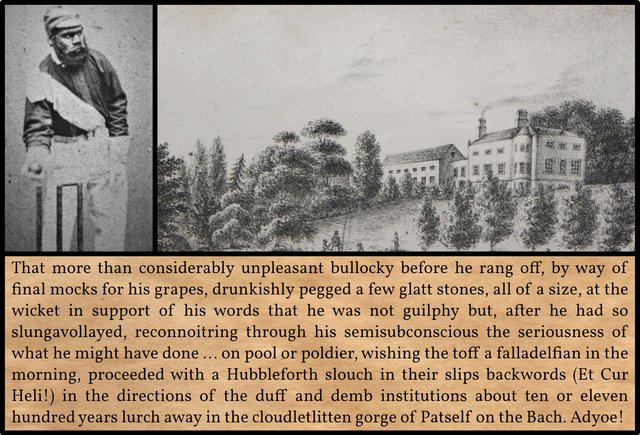
The last ten pages of Chapter 3 of James Joyce’s Finnegans Wake comprise an episode known as The Battery at the Gate. This paragraph recounts the end of the actual battery, as HCE’s attacker final departs the scene. In the original edition of 1939 there was no paragraph break before That more than .... Danis Rose & John O’Hanlon restored it for their revised edition of 2010.
The first draft of this passage consisted of just a single transparent sentence:
The bullocky finally rang off & left the scene after exhorting him to come out so that he cd burst him up, proceeding in the direction of the deaf & dumb institute. ―Hayman 74
After completing this initial draft, Joyce immediately went on to write what would become the opening paragraph of the following chapter. Initially, he did not envisage a change of chapter at this point. As we saw in an earlier article, the division of The Humphriad into three chapters of Finnegans Wake was largely the result of happenstance. Joyce was required to split this expansion of his sketch Here Comes Everybody into three installments for publication.
- rang off In the last paragraph HCE’s refuge took the form of a telephone booth, and it seemed to be implied that the conflict between him and his attacker was taking place over the phone. Ran off is probably also intended.

the deaf & dumb institute As HCE’s attacker departs, silence falls. This is probably the reason for the detail about the deaf-and-dumb institute. In Joyce’s day there were two deaf-and-dumb institutes in Dublin, one Protestant and one Catholic. The latter, St Mary’s School for Deaf and Dumb Females in Cabra, was run by the Dominican Sisters. We have just been told that the Dominican Mission was taking place (058.07), so this may be the institution indicated. In 1816 Charles Orpen founded the National Institution for the Deaf and Dumb at Claremont in Glasnevin. This was the country’s first school for deaf children. In the final version, Joyce replaced the first draft’s institute with institutions, so perhaps he meant both schools. For the record, Cabra and Glasnevin lie in the same direction from Chapelizod: northeast.
bullocky HCE’s attacker is not just a bully. As a pegger of stones, he also resembles a bowler in cricket. Harry Bullocky was an Australian Aboriginal cricketer―a batsman and wicket-keeper rather than a bowler. During the 1868 tour of England, when an Aboriginal team played 39 matches against local teams, Bullocky was mysteriously absent ill for the second innings of the two-day match against the Marylebone Cricket Club at Lord’s. It was rumoured that he had got drunk the night before and was unfit to play―a stigma he never lived down. Hence, when Joyce revised this passage, he added the word drunkishly. The final draft of this paragraph has a cluster of terms taken from cricket, one of Joyce’s favourite sports.
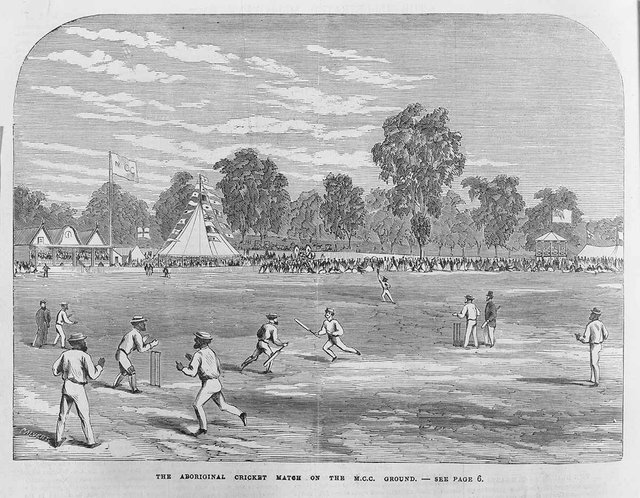
Australia
Another motif that runs through this paragraph is Australia, the hellish underworld of Finnegans Wake. Shem is associated with Australia, and Shaun with America. The Oedipal Figure embodies both brothers.
bullocky We have already met Harry Bullocky. In Australian-English a bullocky is a driver of a bullock team―a team of oxen pulling a wagon. There may also be an allusion to Shane Bullock, the Irish novelist who called Joyce a monster (Glasheen 44).
Australian-English: backblocks, land in the remote and sparsely-populated interior.
he had left Hyland on the dissenting table On leaving Ireland for Australia in 1856, where he would carve out a political career for himself, the Young Irelander Charles Gavan Duffy said: A change might come, but unless the existing condition of things alters, there is no more hope for Ireland than for a corpse on the dissecting-table. Joyce’s alteration of deaf and dumb to duff and demb echoes Duffy’s presence. Charles Hyland was the manager of Dublin’s Gaiety Theatre in the 1920s. His son, another Charles Hyland, was killed during the 1916 Easter Rising while assisting wounded soldiers. Roland McHugh’s Annotations also notes Ireland upon the Dissecting Table, a 1914 political tract by the Irish rebel and Labour activist James Connolly. Connolly was arguing against the proposed partition of Ireland.
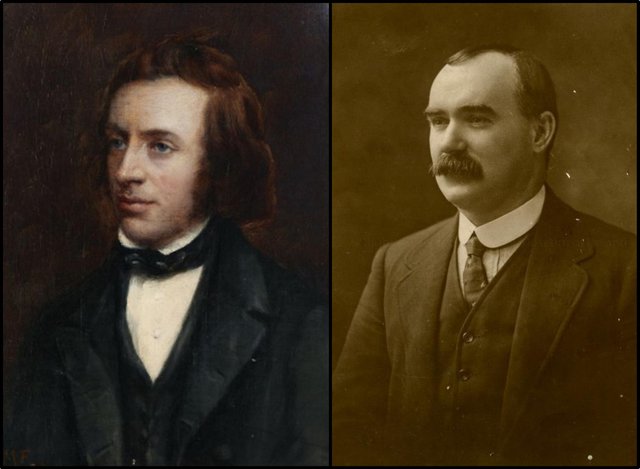
- moonshiny gorge Moonshine Gorge is in the Kimberley region of Western Australia. This is only in the earlier editions of the book. In The Restored Finnegans Wake Danis Rose & John O’Hanlon have replaced the word moonshiny with cloudletlitten.
Stutter
Throughout the Battery at the Gate―indeed, throughout the whole of this chapter―the identities of HCE and his attacker have been difficult to separate. HCE and the Cad are two sides of the same coin. This is confirmed once again in this paragraph by the stuttering of the attacker. In Finnegans Wake stuttering is a common symptom of HCE’s guilt. With his poor hearing (Earweaker) and his stutter, HCE is sort of deaf and dumb:
... exhorting Earwicker ... to cocoa come outside ...
be Cacao Campbell
But why is the stuttering in this paragraph associated with cocoa? Dr Tibbles’ Vi-Cocoa pops up a few times in Finnegans Wake. Perhaps its alleged restorative properties place it on the same level in the Wake as whiskey―uisce beatha, or water of life. Both are mythical potions that can raise the dead to life?

Music
The final lines of this paragraph contain a cluster of musical allusions, which continue into the following paragraph. These hark back to Hosty’s Rann, which brought the preceding chapter to a close:
the rage of Malbruk Malbrough s’en va-t-en guerre (Marlborough Goes to War), a popular 18th-century French folk song about the supposed death and burial of the First Duke of Marlborough (referred to as Malbrouk in some versions of the song). The song is quoted in Beethoven’s Wellington’s Victory, or the Battle of Vitoria, Ruggero Leoncavallo’s comic operetta Malbruk, and numerous other works. The plot of Malbruk is similar to that of Wagner’s Tristan und Isolde. Malbruk is the King of Lower Navarre. His nephew Renaldo, Captain of his Guard of Honour, has an affair with his wife Alba.
his manjester’s voice His Master’s Voice, the name of a record label created in 1901 by The Gramophone Company, a British recording company. Their logo, which depicts a dog listening to an oldfashioned phonograph, was based on Francis Barraud’s oil painting of his brother’s dog Nipper listening to a phonograph recording. The painting was also used as the trademark and logo of the Victor Talking Machine Company, later known as RCA Victor.
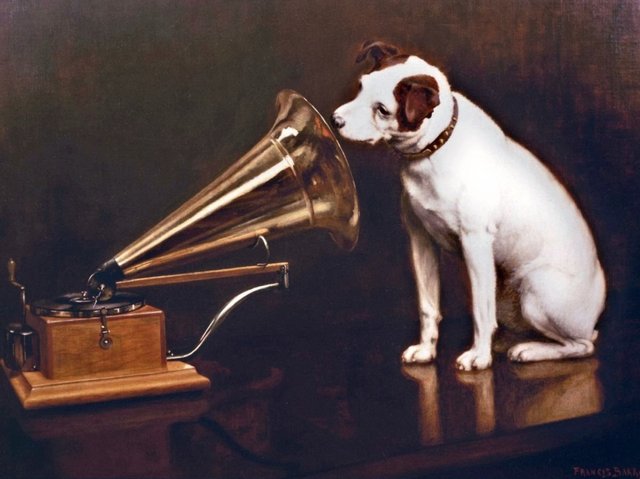
fuguall fugal, pertaining to a fugue.
tropical a trope is a newly-composed piece of music inserted into pre-existing plainchant.
Opus Elf, Thortytoe Opus 11, Number 32 (German: elf, eleven). In music, a composer’s published composition are listed in terms of their opus numbers.
his bandol eer his solgier ... toff a falladelfian in the morning Off to Philadelphia in the Morning: “With my bundle on my shoulder, There’s no one could be bolder, And I’m off to Philadelphia in the morning.” This stage-Irish song was originally written around 1873 by John Lundy but only became popular when it was revised in 1889 by Stephen Temple. The music was adapted by Battison Hayes from a traditional Irish melody. Philadelphia means brotherly love, which always carries overtones of the sibling rivalry of Shem & Shaun.
Bach The German composer Johann Sebastian Bach was famous for his mastery of the fugue.
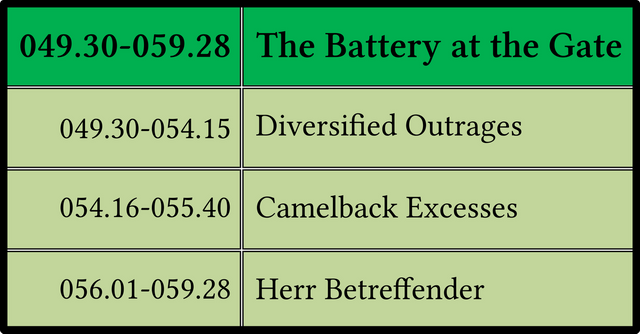
And that’s as good a place as any to beach the bark of our tale.
References
- Adaline Glasheen, Third Census of Finnegans Wake, University of California Press, Berkeley, California (1977)
- David Hayman, A First-Draft Version of Finnegans Wake, University of Texas Press, Austin, Texas (1963)
- James Joyce, Finnegans Wake, The Viking Press, New York (1958, 1966)
- James Joyce, James Joyce: The Complete Works, Pynch (editor), Online (2013)
- Danis Rose, John O’Hanlon, The Restored Finnegans Wake, Penguin Classics, London (2012)
Image Credits
- Harry Bullocky: Anonymous Photo, Public Domain
- Claremont Institution: Joseph Humphreys (artist), Allens’, Dame Street, Dublin (lithographers), Public Domain
- St Mary’s School for Deaf and Dumb Females, Cabra: Anonymous Postcard, Public Domain
- Australian Aborigines versus MCC: Samuel Calvert (illustrator), State Library of Victoria, Public Domain
- Charles Gavan Duffy: Beatrice M Franklin (artist), National Gallery of Ireland, Public Domain
- James Connolly: Lafayette (photographers), National Museum of Ireland, Public Domain
- Moonshine Gorge: © El Questro Wilderness Park, Fair Use
- His Master’s Voice: Francis Barraud (artist), Private Collection, Public Domain
Useful Resources
- FWEET
- Jorn Barger: Robotwisdom
- Joyce Tools
- The James Joyce Scholars’ Collection
- FinnegansWiki
- James Joyce Digital Archive
- From Swerve of Shore to Bend of Bay
